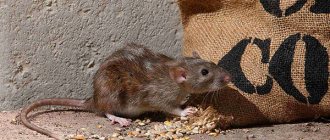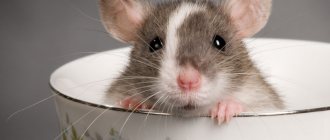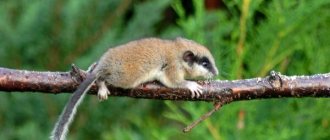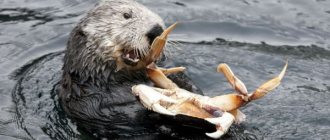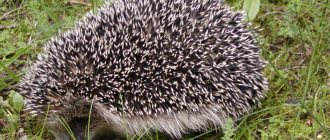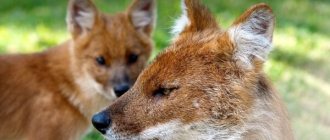- Wild animals
- >>
- Mammals
The water rat or water vole is a frequently encountered animal in our area. A small rodent that lives near water bodies. These are very cute and harmless animals in appearance, however, in agriculture, water rats are considered dangerous pests due to the fact that they cause damage to trees and crops. They are carriers of many dangerous diseases.
Origin of the species and description
Photo: Water rat
The water rat or water vole (Arvicola amphibius) is a small mammal that belongs to the order of rodents, the family of voles. The genus Water Voles includes only one species, Water Voles.
Rodents are very ancient and extremely common animals. Rodents inhabited our planet during the Cretaceous period. The oldest fossils of rodents date back to the Pleocene period, at which time the animals inhabited the territory of modern America. Over time, the appearance of animals has undergone changes, animals have successfully adapted to environmental changes, and at the moment there are 11 families of the rodent order in our country alone.
Video: Water rat
The vole family includes 15 genera. Most species of the vole family are small rodents with a small muzzle, small ears, short legs and a tail. The mouth has strong teeth with which they are able to gnaw through fairly hard wood. The fur of most rodents is short, while that of the water rat is long and thick. The Water Rat has a particularly long tail, which is slightly flattened on the sides, and there are no webbed toes on the hind feet. Water rats differ from other rats in having small, almost non-protruding ears, from gray voles in their large size, and from muskrats in the shape of their tail.
Palevaceae are one of the most numerous groups of rodents that can easily tolerate harsh environmental conditions and feed on low-nutrient foods such as greens, bark and roots of trees and shrubs, and grains. Water rats settle near bodies of water, but can also live in a field next to a body of water and in the forest. Animals of this species are active around the clock and live in burrows. They do not hibernate.
Preventive measures against voles
In addition to using various baits, be sure to keep the area clean; In late autumn, in order to protect against frost and pests, tie tree trunks with covering materials. After every big snowfall on thaw days, the snow around the trees needs to be trampled down: compressed, after a cold snap, it becomes an insurmountable obstacle for rodents.
When removing dead animals from the territory, you should remember that they are carriers of tularemia, a dangerous infectious disease. Therefore, under no circumstances should you pick up a vole with your hands.
Subsequently, in order to prevent water voles from entering the landscaped area, it is recommended to erect a fence on a solid, deep (at least 40 cm) foundation. It is important to ensure that there are no gaps in the fence sections or attachment points through which water voles could enter.
Appearance and features
Photo: What a water rat looks like
The water rat is a small mammal. The length of the animal is about 140-220 mm. Depending on the habitat and quality of life of the animal, body size and weight can vary greatly. On average, the body weight of a water rat is from 130 to 350 grams. The animal's body is massive and clumsy. On the feet, the third toe is longer than the others. There is no hair on the heels. The tail is long in size, equal to half the length of the body, round in cross-section. The ring scales on the tail are absent and there is sparse hair.
The tip of the tail ends in a tassel 0.5 cm long. The color of the animal can vary from red to black. In different seasons, the color of the animal practically does not change. The water rat's fur is soft and fluffy. The cover is differentiated into underfur and rough axis. The rat's belly has lighter fur than its sides and back. In appearance, the animal is similar to a rat, but differs in fluffy fur, tail shape and larger size. The eyes are small and black. The ears are small and practically do not protrude from the fur; also, due to the long fur, the animal’s paws are almost invisible. In the mouth, the incisors are brownish in color, the animal has 16 teeth. Females and males have no external differences.
The stride length is 7-8 centimeters, they are larger than those of ordinary voles. Water voles are very good and fast swimmers, can swim quite long distances, and are able to obtain food for themselves under water. On land they run quite quickly, especially if the animal is scared. They communicate with each other by squeaking. The lifespan of a water rat is 3-4 years.
Theoretical information
Whiskers help the rat maintain orientation in any space.
The vibration frequency of the whiskers is 8 Hertz. Certain species of rats can be very large: for example, Gambian rats grow up to 4 kg. The French entrusted the rat with space exploration in 1961. The female rat carries her babies for about 21 days, and immediately after giving birth she is ready to conceive again. In just three months, a rat can become the mother of hundreds of babies. Water rat
But despite such a high birth rate of these animals, there are only two rats for every person. The skeleton of an individual rat, increased to the average height of a human, has the same structure of joints and the same number of bone elements. Heart pulsation reaches half a thousand beats per minute. Rat tail hairs are one of the necessary elements for eye surgeries. It will take the rat half a second to sense the direction of the smell. Being at very distant distances, rats will accurately determine the location of food. Using their sense of smell, rats recognize members of their family and can even stake out areas. And among the rats there are watchers!
Rats' teeth grow throughout their entire, albeit short, lives. That is why they always need to chew something to grind off the excess part. Rats can easily chew through both metal and concrete products. Rats are not able to sweat, and their temperature is measured by their own tail. They communicate in their own language, which only they understand, using a throat whistle.
The water (field) rat is part of the hamster family. The animal owes its name to its habitat, since there will definitely be a body of water next to it - a river, lake or pond. Although during the flood period the vole prefers to move to meadows or vegetable gardens. In length, including the tail, the rat grows up to 25 cm. The body is massive, has a brown color, the fur is dense and thick, the muzzle is blunt. It digs long burrows for its home, which has a negative impact on the vegetable garden. Residents of private houses or owners of summer cottages often encounter this pest, but they cannot cope with it. During the summer, the female gives birth to offspring 2-3 times, and the number of cubs can reach up to 10. As a result, two dozen rats can breed up to 150-300 individuals over the summer, which will lead to the depletion of any crops.
Where does the water rat live?
Photo: Water rat in Russia
The habitat of these animals is extremely wide; in our country, water rats can be found almost everywhere. Water rats inhabit the entire northern part of Eurasia from the Atlantic to Yakutia. To the south, the habitat of these animals extends from the Mediterranean Sea to Asia and northern China. Also, these animals are extremely common in the northern part of Mongolia, Ukraine, Belarus, the North Caucasus and Siberia (except the Arctic).
Water rats settle in river openings, near lakes, ponds and other bodies of water. For life it chooses places with a humid climate. In the North, settling in forest zones occurs on the banks of reservoirs, peat bogs, which are overgrown with pine and birch trees. In the steppe, it lives in swamps and on the shores of lakes around which sedge and reeds grow.
With the onset of cold weather, these animals move to forests, or to gardens and orchards, where these animals can more easily obtain food for themselves. Capable of migrating over long distances. A vole can overwinter under a haystack, or underground in a burrow. Water rats build burrows near water; during floods, they can build open nests in thickets of grass and reeds. In autumn it digs holes in meadows and fields. The length of the hole is about 3 meters; in winter the holes do not freeze, and the animals can easily survive the winter.
Now you know where the water rat is found. Let's find out what the water vole eats.
Geographical distribution
The water vole, like other voles, is widespread in a wide range covering almost all of Europe (with the exception of some areas of the Iberian Peninsula and France) up to Siberia and in the vicinity of the Pacific coast - in the south the species reaches Israel, Iran, Lake Baikal and south-west western China.
In Italy, this rodent is found throughout the entire peninsula, with the exception of the highlands, although, despite some reports, its presence in Sicily is not certain.
What does a water rat eat?
Photo: Water rat in the garden
The water rat is a herbivore and feeds exclusively on plant foods.
The diet of a water rat includes:
- reed;
- cane;
- sedge;
- arrowhead;
- horsetail;
- waterfowl and algae;
- water lily roots;
- rhizomes and tree bark;
- young shoots of bushes;
- vegetables fruits;
- moss;
- plant seeds, spikelets of grain crops.
In the summer, rats get their food near a pond, where they feel completely safe. Minks and rats dig out the entrance near a pond, so that when leaving the water you can immediately hide in the hole in case of danger. In autumn, these animals move to forests or closer to fields and cultivated plantings.
In winter, they feed mainly on the bark and rhizomes of fruit trees and shrubs, causing them irreparable harm. Therefore, farms are actively fighting these rodents. Water rats are not picky eaters, so they are able to survive even in the harsh conditions of Siberia and Yakutia.
Interesting fact: Water rats feed only in specially designated areas. They arrange “feeding tables” or “feeding holes” for themselves where the animal can eat in peace. Such places can be recognized by the presence of various scraps on them in the form of half-eaten leaves and stems.
In captivity, water rats are fed grain, grass, melons and various fruits and vegetables.
Interesting to know!
If optimal conditions are created for the life of a mammal, the field mouse will multiply very quickly. Up to 400 pests can be counted on one hectare.
The pest rests calmly in its shelter during the daytime, and goes out hunting during the day. This is the second reason preventing the fight against the earth rat. The rodent can rarely be found within the city. The stronger representatives of the genus - gray rats - do not allow them into their abode. Yes, they don’t need to. Why leave so many attractive places to live? After all, the main source of food for rodents is in the garden plot - these are the roots of plants and flowers, and loose soil that does not impede their movement. Rats live in the ground, making holes and passages, cutting off the entire root system of plants encountered on their way. This is the third reason why it is difficult to control pests.
Treatment of premises from mice and rats
Features of character and lifestyle
Photo: Water rat vole
Water voles are very calm animals leading a rather secretive lifestyle. In the summer, they live near bodies of water and spend most of their time in the water. By autumn they move closer to human settlements or to forests. There, these animals dig holes and underground tunnels with a large number of entrances from different sides. Before entering the hole, rats gnaw the grass, creating a semblance of a lawn. In the fall, animals store food in their burrows for the winter. Rats store grain, roots and everything they can carry into the hole.
In winter they do not hibernate; they emerge from their burrows by breaking through the snow. In addition to winter supplies, they feed on the bark of fruit trees and shrubs, and plant seeds. Rats live in colonies, but live alone. During floods, animals move to higher ground and sometimes even climb trees. Rats are active around the clock. In the summer, they spend most of their time in the water, swimming in it and getting food. In the fall, it digs holes and creates reserves for the winter. In winter, it emerges from its burrow only to get food for itself.
Water rats are very smart and cunning animals; they have a lot of enemies, but they are able to escape from them very easily and quickly through numerous underground passages. The social structure is undeveloped, they live mostly alone, but the burrows of water rats are often located nearby. Water rats are not aggressive unless they are threatened. People are treated normally in conditions of captivity and recognize their owner. If the animal senses danger, it may bite.
Interesting fact: Water rats are carriers of dangerous diseases such as Omsk fever, tularimia and many other diseases. Therefore, if you see a rat in the wild, you should not pick it up, or pet the animal, it is better to avoid it.
Prevention measures
The fight against water rats involves the use by humans of the following control methods:
- use of ultrasonic repellers. The operating principle of the device is to generate high-frequency signals that are perceived by animals and have a negative effect on their nervous system. Rodents try to leave such places, and humans thereby get rid of pests; attracting biological enemies. For this purpose, an ordinary cat is used; a mechanical option: traps, rat traps, traps; the use of baits based on pesticides.
Thus, the water rat is a calm animal that leads a solitary lifestyle. She is a very smart animal and is famous for her resourcefulness. It stores food reserves for the winter, thereby being able to easily endure the winter. The water rat migrates several times a year, choosing more suitable habitats for itself.
The danger to people consists of damage to agriculture and the transmission of a number of dangerous diseases. It gets used to humans quite quickly and in captivity leads a quiet lifestyle, breeding all year round. Source
Social structure and reproduction
Photo: Water rat in winter
Water voles reach sexual maturity at the age of 2 months. Water rats reproduce very quickly. The mating season falls during the warm season. Over the course of a year, the female manages to bear 2 to 4 litters. The female's first pregnancy of the year occurs in early spring, the last at the end of August. A special peak of reproduction in water rats occurs in July. During the cold season, water rats rarely breed, only if environmental conditions are favorable and food is available with which they can feed their offspring.
In one litter, 5-7 cubs are born. Pregnancy lasts 21 days. Rats are born blind and without fur, but they grow very quickly. The offspring are mainly cared for by the female; the cubs spend the first few weeks of life exclusively in the burrow. At first, the mother feeds the cubs with milk. Over time, little rat pups begin to eat plant food that their mother brings them, and later they begin to get their own food on their own. Already 1.5 -2 months after birth, the young female is ready to reproduce.
Massive outbreaks of numbers often occur among these animals. During such periods, animals populate fields en masse and can cause significant damage to agriculture. Scientists are unable to trace the causes of such massive outbreaks. The range of sharp outbreaks of increases in the number of rats is limited to small areas.
Bait recipes
- Recipe No. 1: dilute 20-25 g of gypsum with 30-40 g of flour and a small amount of vegetable oil. The animal dies from the plaster, which begins to harden when it enters the stomach.
- Recipe No. 2: One part each of gypsum and fried bran and two parts lard. The resulting mixture must be divided into balls and placed in places where rats live.
- Recipe No. 3: combine 20 g of rosin with 20 g of powdered sugar and 15 g of borax.
- Recipe No. 4: Poisoned grain, bait made from it is most effective in the autumn.
- Recipe No. 5: Sugar and malt are mixed in equal proportions into a container with quicklime, and a bowl of water is placed nearby. The rat, having satisfied its hunger, will immediately want to drink. This action will be the final one in her life.
Water voles do not tolerate the smell of garlic, milkweed, blackroot and hazel grouse. A large number of such plants planted on the site will cause a mass exodus of rodents. To ensure the accuracy of the method, it is recommended to place nut leaves, fish heads, and cloves of garlic in the holes.
Natural enemies of the water rat
Photo: What a water rat looks like
The natural enemies of water rats are predators such as:
- foxes;
- caresses;
- minks;
- ferrets;
- otters;
- hawks;
- eagle owls and owls;
- kites and many other birds of prey;
- dogs and cats;
- snakes and lizards.
Almost all predators hunt water rats. However, water rats are quite cautious, intelligent and cunning animals. Sensing danger, a rat can hide from the enemy in a split second; the most important thing is to get to one of the entrances to the hole. On the water, a water rat can hide from persecution by hiding under water. These animals are excellent swimmers and they swim well underwater.
But the main enemy of water rats was and remains man. Water rats cause great damage to agriculture. They destroy cultivated plants and harm fruit trees. Water rats are not poisoned with poisons in the same way that they can poison crops, and rats are quite smart animals and test unfamiliar food. They first bite off a small piece and if they feel that there is something wrong with the food, they don’t touch it anymore.
Farmers install special ultrasonic repellers on their plots that prevent animals from reaching their crops. Water rats are exterminated in large numbers near farms in gardens and vegetable gardens. Animal fur is also highly valued, and many animals are killed for their skins. The skins are harvested in large quantities.
In addition, the number of animals is strongly influenced by the state of the environment. Scientists have noticed that in dry years, with hot summers, the number of water rats decreases sharply. This species is susceptible to diseases such as tularia, Omsk fever often suffers from helminth infections.
Harm to humans
The water rat feels great in grain fields and gardens. When there is a large population, the damage can be colossal. The animal does not so much eat the grain as spoil the fields. Digs numerous passages, holes, leaves a mound of earth on the surface. The stems fall and intertwine with each other. Grain disappears on the ground, loses its properties and presentation.
The crop pest can ruin the harvest of carrots, beets, and potatoes. Only legumes, onions, and garlic are not attractive. Avoids these beds. In gardens, young and old trees suffer from the water rat. The animal gnaws the bark, destroys seedlings, and feasts on the fruits.
On a note!
If there are grain and vegetable storage facilities, it prefers to settle in these places. It winters safely, and with the onset of spring it makes its way closer to swamps, rivers, and other environments.
The water rat is a carrier of serious diseases - leptospirosis, fever, tularemia, and vector-borne diseases. Can eat the infected body of a dead animal, bringing infection to humans. The issue of pest control concerns not only crops, but also health.
Capabilities
The gray rat lives up to 3 years, but this is only if it is not sick, there is plenty of food, and there are no enemies. Usually such an idyll occurs only in laboratories or in home care. In nature, rats rarely live longer than one and a half years. Their abilities are unique. The fact that they anticipate earthquakes is not particularly surprising, because many animals can do this. But the fact that rats can predict where a shell will land is truly amazing. During the war, people, knowing about this talent of rodents, fled to those huts where the rats were hiding. A unique incident occurred in a market in France. It was moved to a new place, and already a day or two before, all the market rats had moved there, although, of course, no one informed them about this. Scientists have found that gray rats make about 5 thousand sounds, that is, they have their own “alphabet”.
These animals remember our faces and feel our character. They are able to pick up the slightest noise even in the 40 kHz range, which is used in electronic repellers. They distinguish two colors - blue and greenish. They dream, love classical music, and know how to laugh.
Nutrition
What does this rodent eat? The gray rat is an omnivore. In nature, its diet consists of insects, lizards, chicks, bird eggs, cereals, root vegetables, and fruits. Rodents living near water eat small fish, mollusks, and crustaceans. Rats that settle in populated areas eat everything that they can steal from a person - any prepared food, any products, garbage, leftovers. It’s hard to understand why, but they chew paper, clothes, shoes, polystyrene foam, wooden products, electrical wiring - in short, everything that their powerful teeth can bite through. In villages, these little monsters eat chickens, newborn rabbits, and bite off the paws of adult rabbits that are locked in small cages. Male rats even eat their own children. Females are a little kinder; they eat only those babies that seem weak to them. They can survive only 4-5 days without food.
